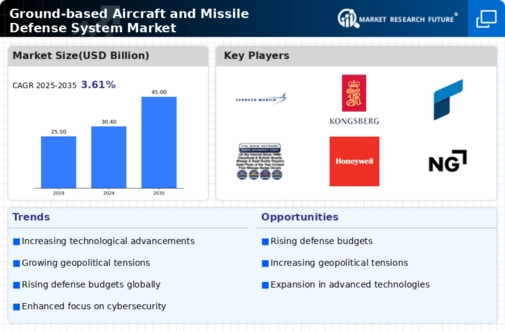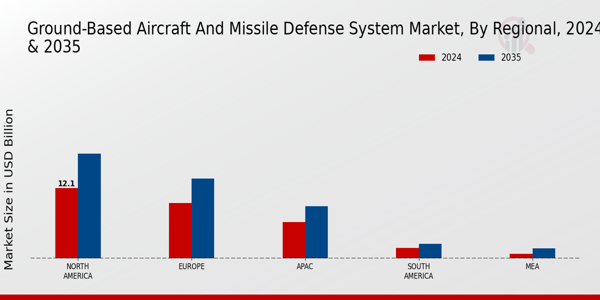Emerging Threats
The Ground-based Aircraft and Missile Defense System Market is responding to the emergence of new threats, which are reshaping defense priorities. The proliferation of advanced missile technologies, including cruise and ballistic missiles, poses significant challenges to national security. As a result, nations are compelled to invest in sophisticated ground-based defense systems capable of countering these threats effectively. Recent assessments indicate that the demand for missile defense systems is expected to grow by over 7% annually, driven by the need to protect airspace from evolving aerial threats. Furthermore, the rise of non-state actors employing unconventional tactics necessitates a reevaluation of existing defense strategies. This dynamic landscape is likely to propel innovation and investment in the ground-based defense sector, ensuring that military capabilities remain robust and responsive to emerging challenges.
Geopolitical Tensions
The Ground-based Aircraft and Missile Defense System Market is heavily influenced by the prevailing geopolitical tensions across various regions. Heightened conflicts and territorial disputes have prompted nations to reassess their defense strategies, leading to increased investments in ground-based defense systems. For instance, areas experiencing military confrontations are witnessing a surge in demand for missile defense capabilities to protect critical infrastructure and civilian populations. This environment of uncertainty compels governments to enhance their defense readiness, resulting in a projected market growth rate of approximately 6% over the next five years. Additionally, the need for advanced systems to counter potential threats from adversaries is driving innovation and procurement in the defense sector, further solidifying the market's expansion.
Focus on Interoperability
The Ground-based Aircraft and Missile Defense System Market is increasingly emphasizing interoperability among defense systems. As military operations become more joint and coalition-based, the ability to integrate various defense platforms is crucial. This focus on interoperability facilitates seamless communication and coordination between different branches of the military and allied forces. For instance, initiatives aimed at standardizing communication protocols and data sharing are gaining traction, enabling more effective responses to aerial threats. Moreover, the integration of systems from different manufacturers is becoming a priority, as it enhances operational flexibility. This trend is likely to drive demand for advanced ground-based defense systems that can operate cohesively within a multi-domain environment, thereby fostering a more robust defense posture.
Increased Defense Budgets
The Ground-based Aircraft and Missile Defense System Market is significantly influenced by the rising defense budgets across various nations. Governments are prioritizing national security, leading to increased allocations for defense spending. For example, recent reports indicate that defense budgets in several countries have risen by an average of 3-5% annually, reflecting a commitment to modernizing military capabilities. This trend is particularly evident in regions facing geopolitical tensions, where nations are investing heavily in ground-based defense systems to safeguard their airspace. The influx of funds allows for the procurement of advanced systems and technologies, thereby enhancing operational readiness. Consequently, this increase in defense budgets is expected to propel the market forward, as countries seek to fortify their defense infrastructures against evolving threats.
Technological Advancements
The Ground-based Aircraft and Missile Defense System Market is experiencing a surge in technological advancements, which are pivotal in enhancing defense capabilities. Innovations such as advanced radar systems, artificial intelligence, and machine learning are being integrated into defense systems, improving detection and response times. For instance, the implementation of phased array radar technology has shown to increase target tracking efficiency by up to 30%. Furthermore, the development of hypersonic missile defense systems is becoming a focal point, as nations seek to counter emerging threats. This technological evolution not only bolsters national security but also drives competition among defense contractors, leading to increased investments in research and development. As a result, the market is likely to witness a robust growth trajectory, with projections indicating a compound annual growth rate of over 5% in the coming years.


















Leave a Comment